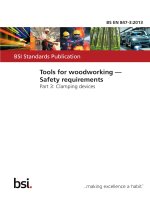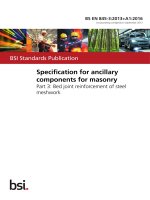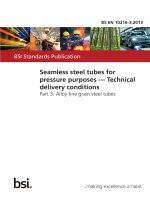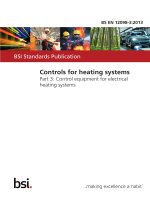Bsi bs en 61587 3 2013
Bạn đang xem bản rút gọn của tài liệu. Xem và tải ngay bản đầy đủ của tài liệu tại đây (1.14 MB, 18 trang )
BS EN 61587-3:2013
BSI Standards Publication
Mechanical structures for
electronic equipment —
Tests for IEC 60917 and
IEC 60297
Part 3: Electromagnetic shielding
performance tests for cabinets and
subracks
NO COPYING WITHOUT BSI PERMISSION EXCEPT AS PERMITTED BY COPYRIGHT LAW
raising standards worldwide™
BRITISH STANDARD
BS EN 61587-3:2013
National foreword
This British Standard is the UK implementation of EN 61587-3:2013. It is
identical to IEC 61587-3:2013. It supersedes BS EN 61587-3:2006 which is
withdrawn.
The UK participation in its preparation was entrusted to Technical Committee
EPL/48, Electromechanical components and mechanical structures for electronic equipment.
A list of organizations represented on this committee can be obtained on
request to its secretary.
This publication does not purport to include all the necessary provisions of a
contract. Users are responsible for its correct application.
© The British Standards Institution 2013
Published by BSI Standards Limited 2013
ISBN 978 0 580 76827 9
ICS 31.240
Compliance with a British Standard cannot confer immunity from
legal obligations.
This British Standard was published under the authority of the Standards
Policy and Strategy Committee on 31 May 2013.
Amendments issued since publication
Amd. No.
Date
Text affected
BS EN 61587-3:2013
EN 61587-3
EUROPEAN STANDARD
NORME EUROPÉENNE
EUROPÄISCHE NORM
April 2013
ICS 31.240
Supersedes EN 61587-3:2006
English version
Mechanical structures for electronic equipment Tests for IEC 60917 and IEC 60297 Part 3: Electromagnetic shielding performance tests for cabinets and
subracks
(IEC 61587-3:2013)
Structures mécaniques pour équipment
électronique Essais pour la CEI 60917
et la CEI 60297 Partie 3: Essais de performances du
blindage électromagnétique pour les baies
et les bacs à cartes
(CEI 61587-3:2013)
Mechanische Bauweisen für elektronische
Einrichtungen Prüfungen für IEC 60917 und IEC 60297 Teil 3: Schirmdämpfungsprüfungen für
Schränke und Baugruppenträger
(IEC 61587-3:2013)
This European Standard was approved by CENELEC on 2013-03-13. CENELEC members are bound to comply
with the CEN/CENELEC Internal Regulations which stipulate the conditions for giving this European Standard
the status of a national standard without any alteration.
Up-to-date lists and bibliographical references concerning such national standards may be obtained on
application to the CEN-CENELEC Management Centre or to any CENELEC member.
This European Standard exists in three official versions (English, French, German). A version in any other
language made by translation under the responsibility of a CENELEC member into its own language and notified
to the CEN-CENELEC Management Centre has the same status as the official versions.
CENELEC members are the national electrotechnical committees of Austria, Belgium, Bulgaria, Croatia, Cyprus,
the Czech Republic, Denmark, Estonia, Finland, Former Yugoslav Republic of Macedonia, France, Germany,
Greece, Hungary, Iceland, Ireland, Italy, Latvia, Lithuania, Luxembourg, Malta, the Netherlands, Norway, Poland,
Portugal, Romania, Slovakia, Slovenia, Spain, Sweden, Switzerland, Turkey and the United Kingdom.
CENELEC
European Committee for Electrotechnical Standardization
Comité Européen de Normalisation Electrotechnique
Europäisches Komitee für Elektrotechnische Normung
Management Centre: Avenue Marnix 17, B - 1000 Brussels
© 2013 CENELEC -
All rights of exploitation in any form and by any means reserved worldwide for CENELEC members.
Ref. No. EN 61587-3:2013 E
BS EN 61587-3:2013
EN 61587-3:2013
-2-
Foreword
The text of document 48D/527/FDIS, future edition 2 of IEC 61587-3, prepared by SC 48D, "Mechanical
structures for electronic equipment", of IEC TC 48, "Electromechanical components and mechanical
structures for electronic equipment" was submitted to the IEC-CENELEC parallel vote and approved by
CENELEC as EN 61587-3:2013.
The following dates are fixed:
•
•
latest date by which the document has
to be implemented at national level by
publication of an identical national
standard or by endorsement
latest date by which the national
standards conflicting with the
document have to be withdrawn
(dop)
2013-12-13
(dow)
2016-03-13
This document supersedes EN 61587-3:2006.
EN 61587-3:2013 includes the following significant technical changes with respect to EN 61587-3:2006:
EN 61587-3:2013 corrects the errors of EM code descriptions and the frequency range for the shielding
performance is extended up to 3 000 MHz.
Attention is drawn to the possibility that some of the elements of this document may be the subject of
patent rights. CENELEC [and/or CEN] shall not be held responsible for identifying any or all such patent
rights.
Endorsement notice
The text of the International Standard IEC 61587-3:2013 was approved by CENELEC as a European
Standard without any modification.
BS EN 61587-3:2013
EN 61587-3:2013
-3-
Annex ZA
(normative)
Normative references to international publications
with their corresponding European publications
The following documents, in whole or in part, are normatively referenced in this document and are
indispensable for its application. For dated references, only the edition cited applies. For undated
references, the latest edition of the referenced document (including any amendments) applies.
NOTE When an international publication has been modified by common modifications, indicated by (mod), the relevant EN/HD
applies.
Publication
Year
IEC 60297
Title
EN/HD
Year
Series Dimensions of mechanical structures
of the 482,6 mm (19 in) series
HD 493
Series
IEC 60917
Series Modular order for the development of
mechanical structures for electronic
equipment practices
EN 60917
Series
IEC 61000-4-3
-
Electromagnetic compatibility (EMC) Part 4-3: Testing and measurement
techniques - Radiated, radio-frequency,
electromagnetic field immunity test
EN 61000-4-3
-
IEC 61000-5-7
-
Electromagnetic compatibility (EMC) Part 5-7: Installation and mitigation
guidelines - Degrees of protection by
enclosures against electromagnetic
disturbances (EM code)
EN 61000-5-7
-
CISPR 16-1
Series Specification for radio disturbance and
EN 55016-1
immunity measuring apparatus and methods
Series
–2–
BS EN 61587-3:2013
61587-3 © IEC:2013
CONTENTS
1
Scope and object .............................................................................................................. 5
2
Normative references ....................................................................................................... 5
3
Electromagnetic shielding performance test ...................................................................... 6
3.1
3.2
3.3
Electromagnetic shielding performance tests for cabinets and subracks .................. 6
Test condition .......................................................................................................... 6
Test configuration .................................................................................................... 6
3.3.1 Calibration of the reference antenna ............................................................ 6
3.3.2 Transmitting antenna ................................................................................... 6
3.3.3 Receiving antenna ....................................................................................... 6
3.3.4 Reference measurement .............................................................................. 7
3.3.5 Transmitting antenna set-up ........................................................................ 7
3.3.6 Test specimen set-up .................................................................................. 7
3.4 Test requirements ................................................................................................... 7
3.5 Test results ............................................................................................................. 8
3.5.1 General ....................................................................................................... 8
3.5.2 Open field test sites ..................................................................................... 9
3.5.3 Semi-anechoic or full anechoic chambers .................................................. 10
Annex A (informative) Examples of SDA-antenna and measurement .................................... 12
Figure 1 – Typical test equipment configuration ...................................................................... 8
Figure 2 – Example of a measurement data presentation ........................................................ 9
Figure 3 – Set-up for measurement of reference field strength E 1 ........................................... 9
Figure 4 – Set-up for measurement of reference field strength E 2 (cabinet) .......................... 10
Figure 5 – Set-up for measurement of reference field strength E 2 (subrack) ......................... 10
Figure 6 – Set-up for measurement of reference field strength E 1 ......................................... 10
Figure 7 – Set-up for measurement of reference field strength E 2 (cabinet) .......................... 11
Figure 8 – Set-up for measurement of reference field strength E 2 (subrack) ......................... 11
Figure A.1 – A pictorial view of a SDA................................................................................... 12
Figure A.2 – The SDA system ............................................................................................... 12
Figure A.3 – Transmission property of E/O-O/E .................................................................... 13
Figure A.4 – Measurement system for transmission property of E/O-O/E .............................. 13
Figure A.5 – Measurement results ........................................................................................ 14
Figure A.6 – Measurement setup at a measurement site ....................................................... 14
Table 1 – Electric field attenuation levels ................................................................................ 8
BS EN 61587-3:2013
61587-3 © IEC:2013
–5–
MECHANICAL STRUCTURES FOR ELECTRONIC EQUIPMENT –
TESTS FOR IEC 60917 AND IEC 60297 –
Part 3: Electromagnetic shielding performance
tests for cabinets and subracks
1
Scope and object
This part of IEC 61587 specifies the tests for empty cabinets and subracks concerning
electromagnetic shielding performance, in the frequency range of 30 MHz to 3 000 MHz.
Stipulated attenuation values are chosen for the definition of the shielding performance level
of cabinets and subracks for the IEC 60297 and IEC 60917 series. The shielding performance
levels are chosen with respect to the requirements of the typical fields of industrial application.
They will support the measures to achieve electromagnetic compatibility but cannot replace
the final testing of compliance of the equipped enclosure.
The purpose of this standard is to ensure physical integrity and environmental performance of
cabinets and subracks, taking into account the need for different levels of performance in
different applications. It is intended to give the user a level of confidence in the selection of
products to meet his specific needs. This standard in whole or in part applies only to the
empty enclosures, for example cabinets and subracks according to IEC 60297 and IEC 60917
and does not apply to the enclosures when electronic equipment is installed. Chassis may be
tested in the same way as subracks and cases may be tested in the same way as cabinets.
This standard was developed in close relationship to IEC 61000-5-7 but with the specific
focus on subracks and cabinets and the determination of performance levels at the chosen
frequency range.
2
Normative references
The following documents, in whole or in part, are normatively referenced in this document and
are indispensable for its application. For dated references, only the edition cited applies. For
undated references, the latest edition of the referenced document (including any
amendments) applies.
IEC 60297 (all parts), Mechanical structures for electronic equipment – Dimensions of
mechanical structures of the 482,6 mm (19 in) series
IEC 60917 (all parts), Modular order for the development of mechanical structures for
electronic equipment practices
IEC 61000-4-3, Electromagnetic compatibility (EMC) – Part 4-3: Testing and measurement
techniques – Radiated, radio-frequency, electromagnetic field immunity test
IEC 61000-5-7, Electromagnetic compatibility (EMC) – Part 5-7: Installation and mitigation
guidelines – Degrees of protection provided by enclosures against electromagnetic
disturbances (EM code)
CISPR 16-1 (all parts), Specification for radio disturbance and immunity measuring apparatus
and methods
–6–
3
BS EN 61587-3:2013
61587-3 © IEC:2013
Electromagnetic shielding performance test
3.1
Electromagnetic shielding performance tests for cabinets and subracks
Various levels of shielding performance can be achieved depending upon the construction of
the cabinet or subrack. Although shielding performance measurements are of limited value in
predicting the final overall system performance, consistent measurement techniques are vital
to ensure any measure of repeatability. The aim of this standard is to provide comparable
shielding performance testing results from one test laboratory to another (see IEC 61000-4-3).
The test result is valid only for cabinets or subracks determined by equal dimensions and
contents, for example removable covers, door, etc. The standard should be used for the
evaluation of design variations.
3.2
Test condition
All testing shall be performed in a semi-anechoic or full anechoic chamber or open field test
site as illustrated in the figures. When the semi-anechoic chamber or the open field test site is
used, the chamber shall meet the vertical and horizontal site attenuation test described in
CISPR 16-1. For the test set-up in the open field or an anechoic chamber, see Figures 3 to 8.
3.3
3.3.1
Test configuration
Calibration of the reference antenna
The purpose of calibration is to check the characteristics of the reference antenna, which is
the output level of a transmitting antenna and the sensitivity level of a receiving antenna.
The test shall be performed by setting the transmitting antenna facing the receiving antenna.
The direction of the transmitting antenna is at 0° and the radiated field strength is maximum.
The height of the transmitting antenna shall be set at 1,1 m.
The receiving antenna shall be positioned 1 m high and 3 m in distance from the transmitting
antenna. The frequency is 100 MHz and 500 MHz.
Calibration shall be made using both horizontal and vertical antenna polarities.
3.3.2
Transmitting antenna
The transmitting source shall be a Spherical Dipole Antenna (SDA) see Annex A or similar
(see Note 1 in Table 1). The size of the transmitting antenna should be equal or smaller than
150 mm in diameter. The equivalency to the SDA should be evaluated by an analysis of the
radiation pattern of the alternative antenna. Annex A illustrates the application of a spherical
dipole antenna (SDA). It is necessary to confirm whether sufficient power level of the
transmitting antenna can be ensured.
The transmitting antenna should be connected to the sender equipment located in outside of
the test specimen without affecting the shielding integrity of the test specimen.
The distance of the transmitting antenna to the metal wall of the enclosure should be at least
the diameter of the spherical antenna. The dynamic range of the measuring equipment should
be determined with the appropriate level above the expected attenuation level as shown in
Table 1.
3.3.3
Receiving antenna
The receiving antenna shall be one of the following types:
BS EN 61587-3:2013
61587-3 © IEC:2013
–7–
–
30 MHz to 200(300) MHz biconical antenna;
–
200(300) MHz to 1 000 MHz log periodic antenna.
The change from biconical to the log periodic may be at 200 MHz or 300 MHz (see Note 1 in
Table 1).
Alternatively, a combined biconical/logarithmic-periodic antenna for the whole frequency
range up to 1 000 MHz may be used.
For the frequency range 1 000 MHz to 3 000 MHz, horn antennas should be used.
3.3.4
Reference measurement
Reference measurements E 1 (dBµV) are made without the test specimen. The transmitting
antenna shall be placed at the position in which it will be once the test specimen is present.
The transmitting antenna shall be positioned at 3 m distance from the receiving antenna and
the two antennas shall face each other in the same direction as that of the calibration.
Measurements shall use both horizontal and vertical polarities. Transmitting and receiving
antenna shall be polarized in the same manner. Frequency sweeps shall be in increments of
not greater than 5 MHz between 30 MHz and 3 000 MHz. The receiving antenna shall be
swept through heights of 1 m to 4 m. The greatest signal strength E 1 for each frequency shall
be recorded (see Figures 3 and 6).
3.3.5
Transmitting antenna set-up
The transmitting antenna shall be placed in the centre inside the test specimen in the same
direction as that of the reference measurement and suspended by non-conductive material
(see Note 1 in Table 1).
3.3.6
Test specimen set-up
In the case of a floor-standing cabinet, there shall be an insulation between the cabinet and
the reference plane of the chamber of 100 mm (±5 %). A table top test specimen shall be
placed at a height of 800 mm (±5 %) from the reference plane.
3.4
Test requirements
Measurements shall be made by using both horizontal and vertical antenna polarities. Both
transmitting and receiving antennas shall be polarized in the same manner. Frequency
increment measurements shall be made.
The equipment under test shall be rotated 360° through its vertical axis (via a turntable or
other means) and the maximum signal strength determined in increments of 90°, i.e. a
minimum of four reading points in the frequency range of 30 MHz to 200(300) MHz, 45° in the
frequency range of 200(300) MHz to 1 000 MHz and 30° in the frequency range of 1 000 MHz
to 3 000 MHz.
Frequency sweeps shall be made in increments of not greater than 5 MHz between 30 MHz
and 3 000 MHz. The receiving antenna shall be swept through heights of 1 m to 4 m. The
greatest signal strength E 2 (dBµV) from the combined sweep of the turntable and antenna
height shall be recorded for each frequency. For the typical test equipment configuration, see
Figure 1.
BS EN 61587-3:2013
61587-3 © IEC:2013
–8–
3.5
Test results
3.5.1
General
The enclosure shielding performance is the difference between the appropriate reference
measurement (Figure 3 or 6) and the associated measurement with the antenna within the
cabinet or subrack. Refer to Table 1 for the appropriate test results.
The shielding performance is calculated in decibels as the difference between E 1 and E 2 . For
the shielding performance levels, defined by attenuation values dependent on the frequency
range, see Table 1. A typical graph of a measurement data (E 1 -E 2 ) (dB) presentation is
shown in Figure 2.
Attenuation requirements are based upon the final cabinet/subrack configuration with all vents,
panels, openings, etc., present. For a definition of the minimum shielding performance, see
Note 2 in Table 1.
Table 1 – Electric field attenuation levels
Performance level
Minimum shielding performance
Frequency range
30 MHz to 230 MHz
dB
Frequency range
230 MHz to 1 000 MHz
dB
Frequency range
1 000 MHz to 3 000 MHz
dB
1
20
10
0
2
40
30
20
3
60
50
40
NOTE 1 For the receiving antenna, biconical or log periodic antennas should be used for the frequency range
between 30 MHz and 1 000 MHz and horn antennas should be used for the frequency range between 1 000 MHz
and 3 000 MHz. A spherical dipole antenna (SDA) may be used especially for the installation within the relatively
small subrack as the transmitting antenna. Equivalent SDA can be used. See Annex A on SDA.
NOTE 2
The minimum shielding performance will exclude cavity resonance.
Computer
Signal
generator
E/O
Spectrum
analyzer
Transmitting
antenna
Receiving
antenna
Antenna tower
controller
Antenna
tower
Turntable
controller
Turntable
IEC 351/13
NOTE 1
Electromagnetic shielding in accordance to IEC 61000-5-7,
performance level 1: EMxx20xx (EM code is not fully equivalent to level 1)
performance level 2: EMxx42xx (EM code is not fully equivalent to level 2)
performance level 3: EMxx64xx (EM code is not fully equivalent to level 3)
NOTE 2
E/O is used for fibre optical cable connection.
Figure 1 – Typical test equipment configuration
BS EN 61587-3:2013
61587-3 © IEC:2013
–9–
Shielding performance E1 – E2 (dB)
The antenna, as detailed in Figures 3 to 8, shall be selected as described in 3.5.2 and 3.5.3.
100
80
60
40
20
30
100
200
300
500
1 000
2 000
Frequency (MHz)
3 000
IEC 352/13
Figure 2 – Example of a measurement data presentation
The graph in Figure 2 shows a typical plot from test results.
3.5.2
Open field test sites
Fibre optical cable connection between a sender equipment and a transmitting antenna is an
example for using the SDA.
3m
H2 = 1 ∼ 4 m
Sender equipment
Receiving antenna
H1 = 1,1 m
Transmitting antenna
Fibre optical cable
Reference plane
Coaxial cable
Receiver equipment
IEC 353/13
Figure 3 – Set-up for measurement of reference field strength E 1
BS EN 61587-3:2013
61587-3 © IEC:2013
– 10 –
3m
Transmitting antenna
Receiving antenna
H1 = 1,1 m
100 mm
Sender equipment
H2 = 1 ∼ 4 m
Cabinet
Reference plane
Fibre optical cable
Receiver equipment
Coaxial cable
IEC 354/13
Figure 4 – Set-up for measurement of reference field strength E 2 (cabinet)
3m
Transmitting antenna
Receiving antenna
Fibre optical cable
H1 = 1,1 m
800 mm
Sender equipment
H2 = 1 ∼ 4 m
Subrack
Reference plane
Receiver equipment
Coaxial cable
IEC 355/13
Figure 5 – Set-up for measurement of reference field strength E 2 (subrack)
3.5.3
Semi-anechoic or full anechoic chambers
Fibre optical cable connection between a sender equipment and a transmitting antenna is an
example for using the SDA.
3m
Receiving antenna
Fibre optical cable
Test chamber
H2 = 1 ∼ 4 m
Sender equipment
H1 = 1,1 m
Transmitting antenna
Reference plane
Coaxial cable
Receiver equipment
IEC 356/13
Figure 6 – Set-up for measurement of reference field strength E 1
BS EN 61587-3:2013
61587-3 © IEC:2013
– 11 –
3m
Transmitting antenna
Test chamber
Receiving antenna
Reference plane
Fibre optical cable
H2 = 1 ∼ 4 m
100 mm
Sender equipment
H1 = 1,1 m
Cabinet
Coaxial cable
Receiver equipment
IEC 357/13
Figure 7 – Set-up for measurement of reference field strength E 2 (cabinet)
3m
Transmitting antenna
Test chamber
Receiving antenna
Fibre optical cable
Reference plane
H2 = 1 ∼ 4 m
H1 = 1,1 m
Sender equipment
800 mm
Subrack
Coaxial cable
Receiver equipment
IEC 358/13
Figure 8 – Set-up for measurement of reference field strength E 2 (subrack)
– 12 –
BS EN 61587-3:2013
61587-3 © IEC:2013
Annex A
(informative)
Examples of SDA-antenna and measurement
Figure A.1 shows an example of a spherical dipole antenna (SDA).
IEC 359/13
Figure A.1 – A pictorial view of a SDA
SDA
Antenna
element
Battery
battery
O/E
Fibre optical cable
S.G.
E/O
IEC 360/13
SG:
Signal generator
E/O:
Electrical to optical transformer
O/E:
Optical to electrical transformer
Figure A.2 – The SDA system
BS EN 61587-3:2013
61587-3 © IEC:2013
– 13 –
9
Output level (dBm)
7
5
3
1
–1
–3
–5
10
100
Frequency (MHz)
1 000
10 000
IEC 361/13
Figure A.3 – Transmission property of E/O-O/E
Fibre optical cable
O/E
E/O
S21
Network
analyzer
Coaxial cable
IEC 362/13
Key
S21:
Parameter of insertion loss measured by network analyzer
Figure A.4 – Measurement system for transmission property of E/O-O/E
BS EN 61587-3:2013
61587-3 â IEC:2013
14
Electric field strength (dBàV/m)
100
80
60
40
20
0
10
100
10 000
1 000
Frequency (MHz)
IEC 363/13
Figure A.5 – Measurement results
Absorber
3m
R.A.
1,5 m
1 to 4 m
SDA
R.X.
S.G.
E/O
IEC 364/13
Key
R.A:
Receiving antenna
R.X:
Test receiver/Spectrum analyzer
S.G:
Signal generator
E/O:
Electrical to optical transformer
Figure A.6 – Measurement setup at a measurement site
_____________
This page deliberately left blank
British Standards Institution (BSI)
BSI is the independent national body responsible for preparing British Standards and other
standards-related publications, information and services. It presents the UK view on standards in
Europe and at the international level.
BSI is incorporated by Royal Charter. British Standards and other standardisation products are
published by BSI Standards Limited .
Revisions
Information on standards
British Standards and PASs are periodically updated by amendment or
revision. Users of British Standards and PASs should make sure that they
possess the latest amendments or editions.
It is the constant aim of BSI to improve the quality of our products and
services. We would be grateful if anyone finding an inaccuracy or ambiguity
while using British Standards would inform the Secretary of the technical
committee responsible, the identity of which can be found on the inside front
cover. Similary for PASs, please notify BSI Customer Services.
Tel: +44 (0)20 8996 9001 Fax: +44 (0)20 8996 7001
BSI provides a wide range of information on national, European
and international standards through its Knowledge Centre.
BSI offers BSI Subscribing Members an individual updating service called
PLUS which ensures that subscribers automatically receive the latest editions
of British Standards and PASs.
Tel: +44 (0)20 8996 7669 Fax: +44 (0)20 8996 7001
Email:
Buying standards
You may buy PDF and hard copy versions of standards directly using a
credit card from the BSI Shop on the website www.bsigroup.com/shop.
In addition all orders for BSI, international and foreign standards publications
can be addressed to BSI Customer Services.
Tel: +44 (0)20 8996 9001 Fax: +44 (0)20 8996 7001
Email:
In response to orders for international standards, BSI will supply the British
Standard implementation of the relevant international standard, unless
otherwise requested.
Tel: +44 (0)20 8996 7004 Fax: +44 (0)20 8996 7005
Email:
BSI Subscribing Members are kept up to date with standards developments
and receive substantial discounts on the purchase price
of standards. For details of these and other benefits contact Membership
Administration.
Tel: +44 (0)20 8996 7002 Fax: +44 (0)20 8996 7001
Email:
Information regarding online access to British Standards and PASs
via British Standards Online can be found at
www.bsigroup.com/BSOL
Further information about British Standards is available on the BSI website
at www.bsi-group.com/standards
Copyright
All the data, software and documentation set out in all British Standards and
other BSI publications are the property of and copyrighted by BSI, or some
person or entity that own copyright in the information used (such as the
international standardisation bodies) has formally licensed such information
to BSI for commerical publication and use. Except as permitted under the
Copyright, Designs and Patents Act 1988 no extract may be reproduced,
stored in a retrieval system or transmitted in any form or by any means –
electronic, photocopying, recording or otherwise – without prior written
permission from BSI. This does not preclude the free use, in the course of
implementing the standard, of necessary details such as symbols, and size,
type or grade designations. If these details are to be used for any other
purpose than implementation then the prior written permission of BSI must
be obtained. Details and advice can be obtained from the Copyright &
Licensing Department.
Tel: +44 (0)20 8996 7070
Email:
BSI
389 Chiswick High Road London W4 4AL UK
Tel +44 (0)20 8996 9001
Fax +44 (0)20 8996 7001
www.bsigroup.com/standards
raising standards worldwide™









